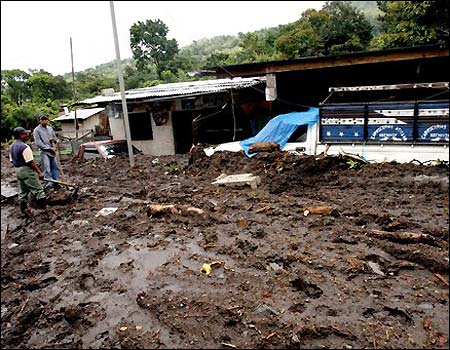Guatemala: Over 1,000 killed in the aftermath of Hurricane Stan
Authorities said they would abandon communities buried by landslides and declare them mass graveyards
More than 100 Guatemalan communities buried by massive landslides are to be declared mass graveyards by local authorities, in the aftermath of Hurricane Stan that left over 1,000 killed in the Central American country. The death toll has now reached 652, with 384 people missing, while some Indian villages are, in effect, mass graves, according to figures released by the army and civil defence rescue teams.
Hurricane Stan also affected Mexico, where left 61 killed and hundreds injured, and El Salvador that suffered from the death of 70 people and major losses to its agriculture.
But Guatemala was by far the most affected country of a region that was once the center of the Mayan civilization. Now, Mayan Indian communities are struggling with the conflicting demands of tradition, which necessitates the recovery of bodies and burial, with the shifting fields of mud. Many now say the vast mudflows will have to be declared graveyards.
"They [the experts] have advised us not to dig any more because there is a great danger" that the still-soaked earth may collapse again, said Uvaldo Najera, a Tacana municipal employee to local reporters. Officials said the 1992 Nobel Peace Prize laureate and a Mayan campaigner for human rights, Rigoberta Menchъ Tum, will visit some of the hardest-hit villages, like Panabaj on the shores of Lake Atitlan, to hold consultations with Indian leaders on how to reconcile cultural traditions, while keeping the living from being injured in attempts to recover the dead.
But national authorities are concered about a greater damage coming from the necessities of the ancient traditions. The worst-hit communities will be abandoned and declared graveyards, officials said, after they stopped most efforts to dig out increasingly decomposed bodies.
"Panabaj will no longer exist," said Mayor Diego Esquina, referring to the Mayan hamlet on the shores of Lake Atitlan covered by a half-mile-wide mudflow as much as 15 to 20 feet thick. "We are asking that it be declared a cemetery. We are tired; we no longer know where to dig." The village is lying under a mudflow 800 metres wide and four to six metres deep. Many of the missing will be declared dead and the ground they are buried in consecrated.
A vibrant centre of Tz'utuhil Maya culture, the Santiago Atitlan region is famous for maintaining its traditional Indian ways despite outside political pressure and the encroachment of tourism. The region was a rallying place for Indian resistance during Guatemala's 36-year civil war, which ended in 1996 and resulted in the deaths of about 200,000 peasants.
Photo: Panabaj buried by mud, some 200 kilometers north of Guatemala City.
Subscribe to Pravda.Ru Telegram channel, Facebook, RSS!





